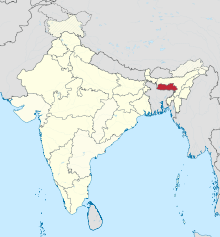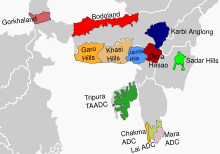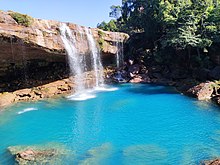Meghalaya
On 3 January 1921 in pursuance of Section 52A of the Government of India Act of 1919, the governor-general-in-council declared the areas now in Meghalaya, other than the Khasi states, as "backward tracts."The important rivers in the Garo Hills region are Ganol, Daring, Sanda, Bandra, Bugai, Dareng, Simsang, Nitai and the Bhupai.The highest point in the Garo Hills is Nokrek Peak with an altitude of 1515 m.[citation needed] With the average annual rainfall as high as 12,000 mm (470 in) in some areas, Meghalaya is the wettest place on Earth.[37] Prominent birds spotted in Meghalaya include those from the families of Phasianidae, Anatidae, Podicipedidae, Ciconiidae, Threskiornithidae, Ardeidae, Pelecanidae, Phalacrocoracidae, Anhingidae, Falconidae, Accipitridae, Otididae, Rallidae, Heliornithidae, Gruidae, Turnicidae, Burhinidae, Charadriidae, Glareolidae, Scolopacidae, Jacanidae, Columbidae, Psittacidae, Cuculidae, Strigidae, Caprimulgidae, Apodidae, Alcedinidae, Bucerotidae, Ramphastidae, Picidae, Campephagidae, Dicruridae, Corvidae, Hirundinidae, Cisticolidae, Pycnonotidae, Sylviidae, Timaliidae, Sittidae, Sturnidae, Turdidae, Nectariniidae and Muscicapidae.Other regional birds found include the grey peacock pheasant, the large Indian parakeet and the common green pigeon.Other groups include the Bengali, Hajongs, the Biates, the Koches and related Rajbongshis, the Boros, Dimasa, Kuki, Lakhar, Tiwa (Lalung), Karbi, Rabha and Nepali.[citation needed] Meghalaya recorded the highest decennial population growth of 27.82% among all the seven north-eastern states, as per the provisional report of census 2011.[60] The most spoken languages in Meghalaya are Khasi (33.82%) and Garo (31.60%) followed by Pnar (10.69%), Bengali (6.44%), Nepali (1.85%), War (1.73%), Hindi (1.62%), Hajong (1.40%) and Assamese (1.34%).The West Garo Hills district lies in the western part of the state and covers a geographical area of 3,714 square kilometres (1,434 sq mi).To provide local self-governance machinery to the rural population of the country, provisions were made in the Constitution of India; accordingly, the Panchayati Raj institutions were set up.[citation needed] Infrastructural constraints have also prevented the economy of the state from creating high-income jobs at a pace commensurate with that of the rest of India.Besides these, potato, ginger, turmeric, black pepper, areca nut, Bay leaf (Cinnamomum tamala), betel, short-staple cotton, jute, mesta, mustard and rapeseed etc.Climatic conditions in Meghalaya permit a large variety of horticulture crops including fruits, vegetables, flowers, spices, mushrooms, and medicinal plants.The low level of industrialisation and the relatively poor infrastructure base acts as an impediment to the exploitation of these natural resources in the interest of the state's economy.The Khasi and Jaintia tribesmen follow the traditional matrilineal norm, wherein the Khun Khatduh (or the youngest daughter) inherits all the property and responsibilities for the family.This includes examples such as sports, religious, educational, and other clubs that aim to establish individuals into different social circles based on their interests.Some argue for its important role in state development through CSOs, while others point out that their impact is not only limited from above by the central government and its military, but also from below by insurgent groups .Many insurgent organisations were also developed alongside cultural and political movements, making it very difficult to distinguish them from what constitutes a civil society.[85][87] All the three major ethnic tribal groups, namely, the Khasis, Jaintias and the Garos also have their own traditional political institutions that have existed for hundreds of years.The main festivals of Garos are Den Bilsia, Wangala, Rongchu gala, Mi Amua, Mangona, Grengdik BaA, Jamang Sia, Ja Megapa, Sa Sat Ra Chaka, Ajeaor Ahaoea, Dore Rata Dance, Chambil Mesara, Do'KruSua, Saram Cha'A, A Se Mania or Tata.Large numbers[99] of these man-made living structures exist in the mountainous terrain along the southern border of the Shillong Plateau, though as a cultural practice they are fading, with many individual examples having disappeared recently, either falling in landslides or floods or being replaced with more standard steel bridges.To provide better services to the people of the state, the Meghalaya Public Works Department is taking steps for improvement and up-gradation of the existing roads and bridges in phased manner.[102] Guwahati (103 kilometres (64 mi) from Shillong) is the nearest major railway station connecting the north-east region with the rest of the country through a broad gauge track network.Until 1955, foreign tourists required special permits to enter the areas that now constitute the state of Meghalaya, which are sometimes compared to Scotland for their highlands, fog and scenery.Meghalaya also offers many adventure tourism opportunities in the form of mountaineering, rock climbing, trekking, and hiking, caving (spelunking) and water sports.The Umiam Lake has a water sports complex with facilities such as rowboats, paddleboats, sailing boats, cruise-boats, water-scooters, and speedboats.They are small or large areas of forests or natural vegetation that are usually dedicated to local folk deities or tree spirits or some religious symbolism over many generations, often since ancient times.The Umiam Lake (popularly known as Bara Pani meaning Big water) on the Guwahati-Shillong road is a major tourism attraction for tourist.[114] Chief Minister Mukul Sangma, in August 2012, called upon Government of India to take corrective measures to stop the illegal immigration of Bangladeshis into the northeast of the country before the situation goes out of hand.[123] A 2001 satellite imaging study showed that shift cultivation practice continues and patches of primary dense forests are lost even from areas protected as biosphere.



















MeghalayanNohkalikai FallsUmngot RiverEmblem of MeghalayaRegionNortheast IndiaFormationCapitaland largest cityShillongDistrictsGovernment of MeghalayaGovernorC. H. VijayashankarChief ministerConrad SangmaState LegislatureAssemblyMeghalaya Legislative Assembly60 seatsParliament of IndiaRajya SabhaLok SabhaHigh CourtMeghalaya High CourtLushai HillsDemonymOfficialEnglishOfficial scriptLatin scriptTime zoneISO 3166 codeVehicle registrationLiteracySex ratioHill mynaFlowerLady's Slipper OrchidMammalClouded leopardGamharList of Indian state symbolsKhasi HillsJaintia HillsGaro HillsBangladeshiMymensinghSylhetRangpurState of AssamBritish rule of Indiafollowed a matrilineal systemMeghalaya subtropical forestsecoregionbiodiversityagrarian economypineapplesinsurance companiesInternational Commission on StratigraphyHolocenespeleothemstratotypeCentral InstitutesNorth Eastern CouncilSanskritNeolithic periodConquest of TarafShah JalalKhasi and Jaintia HillsIslamic monotheismkhanqahKamarupaCamellia sinensispartitioned on 16 October 1905Lord CurzonEastern Bengal and AssamGovernment of India Act of 1919Government of India Act 1935S.P. ChatterjeeNorth-Eastern Areas (Reorganisation) Act, 1971Legislative AssemblySeven Sister StatesArcheanlimestoneuraniumsillimaniteShiba P. ChatterjeeUniversity of CalcuttaSimsangCherrapunjiMawsynramsacred grovesSacred groves of IndiaNokrek Biosphere ReserveBalpakram National Parkpitcher plantNepenthes khasianaparasitesepiphytessucculent plantsshrubsShorea robustaTectona grandismammalsreptilesred pandassmall Indian civetsmongoosesweaselsrodentswild buffalowild boarprimatesSiju Cavehoolock gibbonlizardscrocodilestortoisespythoncopperheadIndian cobraking cobracoral snakevipersSoutheast Asia

